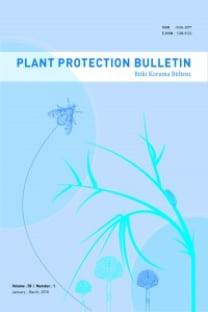Ankara ili kışlık sebze üretim alanlarında Cauliflower mosaic virus’u ve vektörlerinin serolojik ve moleküler olarak tanılanması
Serological and molecular detection of Cauliflower mosaic virus and its vectors infecting cold-season vegetables in Ankara province
CaMV, cold season vegetables, ELISA PCR, Brevicoryne brassicae,
___
- Akcura C., Şevik M.A., 2015. Samsun ili yaprak lahana üretim alanlarında görülen virüslerin belirlenmesi. Yüzüncü Yıl Üniversitesi, Tarım Bilimleri Dergisi, 26 (2), 196-201.
- Alan B., 2012. Doğu Akdeniz Bölgesi’nde yetiştirilen bazı kışlık sebzelerde hastalık yapan virüslerin tanılanması ve karakterizasyonu. Çukurova ÜnivErsitesi, Fen Bilimleri Enstitüsü Bitki Koruma Anabilim Dalı, Doktora Tezi, Adana, XIV, 134 s.
- Benfey P.N., Ren L., Chua N.H., 1989. The CaMV 35S enhancercontains at least two domains which can confer different developmental and tissue-specific expression patterns. The EMBO Journal, 8 (8), 2195–2202.
- Clark M.F., Adams A.M., 1977. Characteristics of the microplate method of enzyme-linked assay for the detection of plant viruses. The Journal of General Virology, 34 (3), 475-483.
- Day M.F., Venables D.G., 1960. The transmission of cauliflower mosaic virus by aphids. Australian Journal of Biological Sciences, 14, 187–197.
- Erkan S., Eşiyok D., Eser B., 1990. A new viral agent affecting cauliflower and cabbage plants in Turkey. Journal of Turkish Phytopathology, 19 (2), 95-97.
- Erkan S., Gümüş M., Paylan İ.C., Duman İ., Ergün M., 2013. İzmir ili ve çevresindeki bazı kışlık sebzelerde görülen viral etmenlerin saptanması. Ege Üniversitesi, Ziraat Fakültesi Dergisi, 50 (3), 311-322.
- Fromm M., Taylor L.P., Walbot V., 1985. Expression of genes transferred in to monocot and dicot plant cells by electroporation. Proceedings of the National Academy of Sciences of the United States of America, 82, 5824-5828.
- Fujisawa I., 1990. Turnip mosaic virus strains in cruciferous crops in Japan. Japan Agricultural Research Quarterly, 23 (4), 289-293.
- Fang R.X., Nagy F., Sivasubramaniam S., Chua N.H., 1989. Multiple cis regulatory elements for maximal expression of the cauliflower mosaic virus 35S promoter in transgenic plants. Plant Cell, 1 (1), 141–150.
- Farzadfar S., Ahoonmanesh A., Mosahebi G.H., Pourrahim R., Golnaraghi A.R., 2007. Occurrence and distribution of Cauliflower mosaic virus on cruciferous plants in Iran. Plant Pathology Journal, 6 (1), 22-29.
- Hull R., 2002. Matthews‘ Plant Virology. 4th Edition, Elsevier Academic Press, USA, 1001 p.
- Khadye V.S., Sahasrabudhe A.V., 2012. Rapid detection of genetically modified organisms in cotton seeds by real time PCR. International Journal of Life Sciences and Pharma Research, 1 (4), 98-105.
- Korkmaz S., Tomitama Y., Onder S., Oshima K., 2008. Occurence and molecular characterization of Turkish isolates of Turnip mosaic virus. Plant Pathology, 57 (6), 1155-1162.
- Martiniere A., Zarcarini A., Ducker M., 2009. Aphid transmission of CaMV. Plant Signal Behavior, 4 (6), 548-550.
- Moreno A., De Blas C., Biurrun R., Nebreda M., Palacios I., Duque M., Fereres A., 2004. The incidence and distribution of viruses infecting lettuce, cultivated Brassica and associated natural vegetation in Spain. Annals of Applied Biology, 144 (3), 339-346.
- Nguyen H.D., Tomitaka Y., Ho S.Y.W., Duchene S., Vetten H.J., Lesemann D., Ohshima K., 2013. Turnip mosaic potyvirus probably first spread to eurasian brassica crops from wild orchids about 1000 years ago. PLoS One 8 (2), e55336.
- Odell J.T., Nagy F., Chua N.H., 1985. Identification of DNA sequences required for activity of the cauliflower mosaic virus35S promoter. Nature, 313, 810–812.
- Prat S., Willmitzer L., Sanchez-Serrano J.J., 1989. Nuclear proteins binding to a cauliflower mosaic virus 35S truncated promoter. Molecular and General Genetics, 217, 209–214.
- Raybould A.F., Maskell L.C., Edwards M.L., Cooper J.I., Gray A.J., 1999. The prevalence and spatial distribution of viruses in natural populations of Brassica oleracea. The New Phytologist, 141 (2), 265-275.
- Shephard R.J., 1981. Cauliflower mosaic virus. AAB Descriptions of Plant Viruses, Leaflet No. 243.
- Sevik M.A., 2019. Viruses infecting cool season crops in the northern Turkey. Anais da Academia Brasileira de Ciências. 91 (3), e20180224.
- Somma M., 2006. Extraction and purification of DNA. In: Querci M., Jermini M., Van den Eede G., (Eds.), Training course on the analysis of food samples for the presence of genetically modified organisms user manual. Session 4. Luxemburg, European Communities, 1-17.
- Spence N.J., Phiri N.A., Hughes S.l., Mwaniki A., Simons S., Oduor G., Marris G.C., 2007. Economic impact of turnip mosaic virus, cauliflower mosaic virus and beet mosaic virus in three Kenyan vegetables. Plant Pathology, 56 (2), 317-323.
- Tabarestani A. Z., Shamsbakhsh M., Safaei N., 2010. Distribution of three important aphid borne canola viruses in Golestan province. Iranian Journal of Plant Protection Science, 141 (2), 251-259.
- Tuzlalı H.T., Korkmaz S., 2011. Çanakkale ilinde Karnabahar mozaik virusu (Cauliflower mosaic virus-CaMV)’nun serolojik ve moleküler yöntemlerle tanılanması. Türkiye 4. Bitki Koruma Kongresi, Kahramanmaraş, 28-30 Haziran 2011, 396 p.
- Tuzlalı H.T., Korkmaz S., 2014. Çanakkale ilinde Karnabahar mozaik virusu (Cauliflower mosaic virus; CaMV) izolatlarının tanılanması ve karakterizasyonu. Akdeniz Üniversitesi Ziraat Fakültesi Dergisi, 27 (1), 1-7.
- TUIK, 2019. Türkiye İstatistik Kurumu. Bitkisel Üretim İstatistikleri. https://biruni.tuik.gov.tr/bitkiselapp/bitkisel. zul (accessed date: 12.10.2019).
- ISSN: 0406-3597
- Yayın Aralığı: 4
- Başlangıç: 1952
- Yayıncı: Zirai Mücadele Merkez Araştırma Enstitüsü Müdürlüğü
Halil DİLMEN, Mehmet Salih ÖZGÖKÇE
Mohammad Reza AZAMPARSA, Aziz KARAKAYA
Gürsel ÇETİN, Pinar HEPHIZLI, Mustafa ÖZDEMİR, Yilmaz BOZ
Mohammad Reza AZAMPARSA, Aziz KARAKAYA
Duygu MERMER DOĞU, Damla ZOBAR
Gül SATAR, Mehmet Rifat ULUSOY
Aspirdeki Yabancı Otlar Üzerine Bazı Herbisitlerin Etkisinin Belirlenmesi
